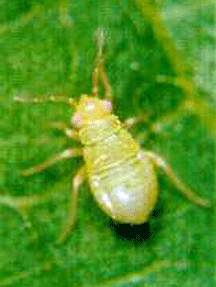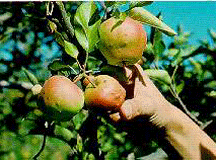Management of mullein bug
Editor’s note: This article is from the archives of the MSU Crop Advisory Team Alerts. Check the label of any pesticide referenced to ensure your use is included.
Information for this article was obtained from research at Washington State University, where mullein bug has been noted as a pest of apple and pear since the 1970's.
Mullein bug, also known by its scientific name, Campylomma, is a sporadic pest of apple that appears to be increasing as a problem in Michigan. It is an unusual insect, spending most of its life cycle as a predator of mites and aphids in apple orchards, but for a short period during bloom, mullein bug also feeds on developing fruit, resulting in fruit with small up-raised bumps with a cork-like appearance, surrounded by conical depressions. Washington State reports that injury can sometimes resemble russet in certain varieties, such as Gala.
Damage to fruit from the mullein bug occurs around bloom-time. Fruit can receive individual or multiple stings, and the large majority of injured fruit abort just prior to, or during, June drop. Affected fruit that do remain on the tree develop the small corky warts or bumps. Washington reports that feeding beyond bloom time does not usually result in damage.
The mullein bug has two to three generations per year in Michigan, and divides its time largely between two main plant hosts – the mullein plant and apple. Research at Washington State University showed that mullein bug has a marked preference for Golden Delicious, with caged Golden Delicious fruit receiving 75 percent injury levels. Other varieties it favors are Red Delicious, Northern Spy, Empire, Spartan, Cortland, Gala, and Jonagold. McIntosh and other cultivars seem to be largely unaffected, but it is not known whether mullein bug does not generally attack fruit of these other cultivars, or if they are immune to mullein bug stings.
Mullein bug nymphs are tiny, oval-shaped and translucent-green in color. They look somewhat like an aphid without “tailpipes,” and have distinctive pink or reddish eyes. Campylomma nymphs can also be confused with white apple leafhopper nymphs. Two features distinguish Campylomma from white apple leafhopper nymphs, a rounded tip to its abdomen and four segmented antennae. Campylomma nymphs and adults are fast moving, especially when disturbed.
Monitoring for the pest phase of mullein bug should start around pink and continue through the bloom period. Once you see the damage, it’s too late to target controls in apple. Visual searches and limb tapping of nymphs onto beating trays are the most common methods for determining pest levels. Washington State research reports that beating trays recover approximately 70 percent of nymphs. Campylomma distribution in an orchard is generally clustered, necessitating a high number of limb taps to accurately determine infestation levels, about 20-50 beating tray samples across 10 acres to accurately determine population density. Where a block of mixed cultivars is present, sampling from the most susceptible varieties is suggested. Choose limbs with fruit clusters since mullein bug are often most present on these. Once tapped onto the beating tray, nymphs move quickly, so be prepared to sight identify them. Action thresholds developed in British Columbia and used in Washington are an average of one nymph per tap in Golden Delicious, and four nymphs per tap for Red Delicious. Washington research in 2004 showed that an average of 1.2 nymphs/tap would produce about one percent fruit injury at harvest in Gala. Blocks with damage last season should be scouted closely for mullein bug during bloom and for two to three weeks after petal fall.
Fruit is susceptible to injury from bloom until fruit reaches about 10 mm in diameter. In western states, there appears to be a consensus of opinion that chemical controls applied from full to late bloom are the most effective. Assail may be the most active of the new compounds (in terms of nymph suppression), and also provided among the best levels of damage prevention. Trials performed in Washington showed that Assail at a 1.2 - 3.4 oz rate applied at bloom provided control equal to that of Carzol at bloom. The ability to make an application during bloom may also be a deciding factor.
Insecticides for Campylomma verbasci (mullein bug)
| Insecticide | Comments |
| Carzol | *Carzol at bloom appears to be excellent, providing high levels of knockdown and good residual control. |
| Assail | *A good campylomma material (and possibly thrips) and since it only has a bee toxicity rating of III, it can be used at bloom when bees are not active. |
| Lorsban | **Good activity, may cause russetting on Golden Delicious. |
| Diazinon | **Good activity, may cause russetting on Golden Delicious. |
| Thiodan | **Recommended chemical. |
| Provado | *Somewhat toxic to campylomma, but cannot be used during the critical period for prevention of damage (bloom). |
| Actara | *Good efficacy against this pest, even though it cannot be used during bloom (pink would be the preferred timing). |
| Calypso | *Has campylomma activity, but perhaps not as strong as Assail. |
| Neemix | *Some suppression has been observed of leafhopper and campylomma. |
*Washington State University Tree Fruit Research and Extension Center.
**Utah State University Extension.
Monitoring of beneficial insects and mites during the summer months should include mullein bug counts. Several weeks after petal fall, the nymphs become predaceous on European red mite and aphids. Nymphs with red bellies are an indication that they have been feeding on mites. Numbers of mullein bug nymphs and adults should be recorded when conducting green apple aphid terminal infestation counts and in predator limb tap sampling throughout the summer, to give an estimate of the importance of mullein bug as a predatory insect in the orchard, especially in non-susceptible cultivars. During the summer, mullein bugs will leave the tree to feed on herbaceous plants, especially mullein. In the fall, adults return to the apple tree to mate and lay overwintering eggs. Pheromone traps are used in western apple production regions to assess this movement back into the orchards and provide an early indication of potential problem orchards for the coming spring.



 Print
Print Email
Email






